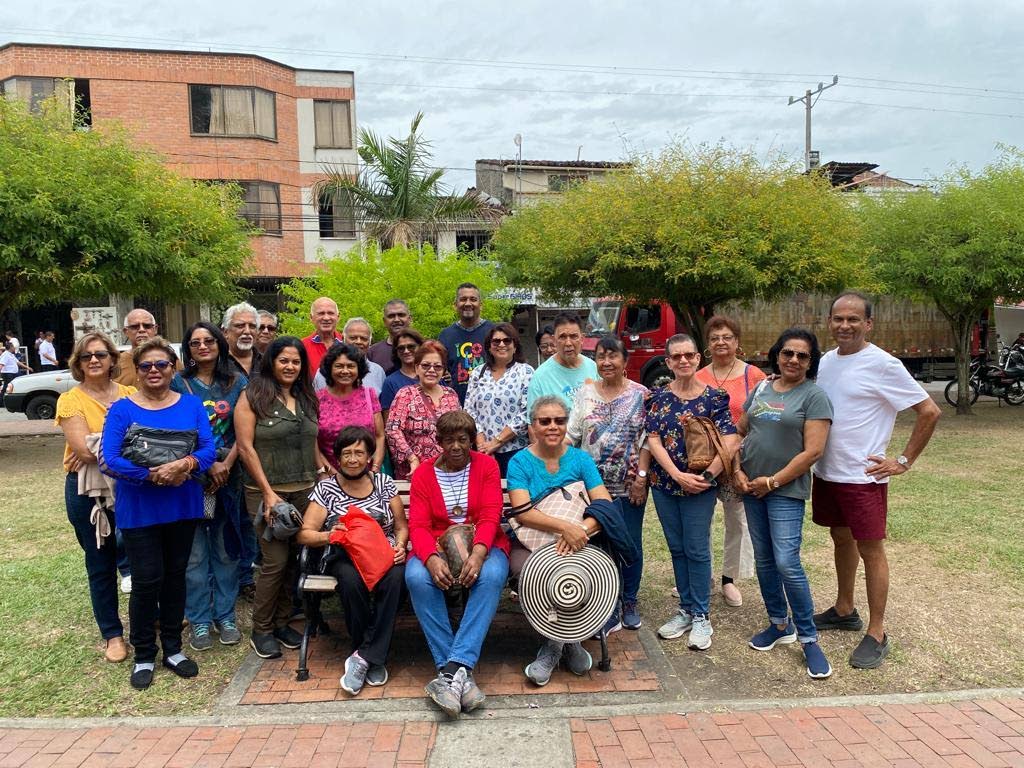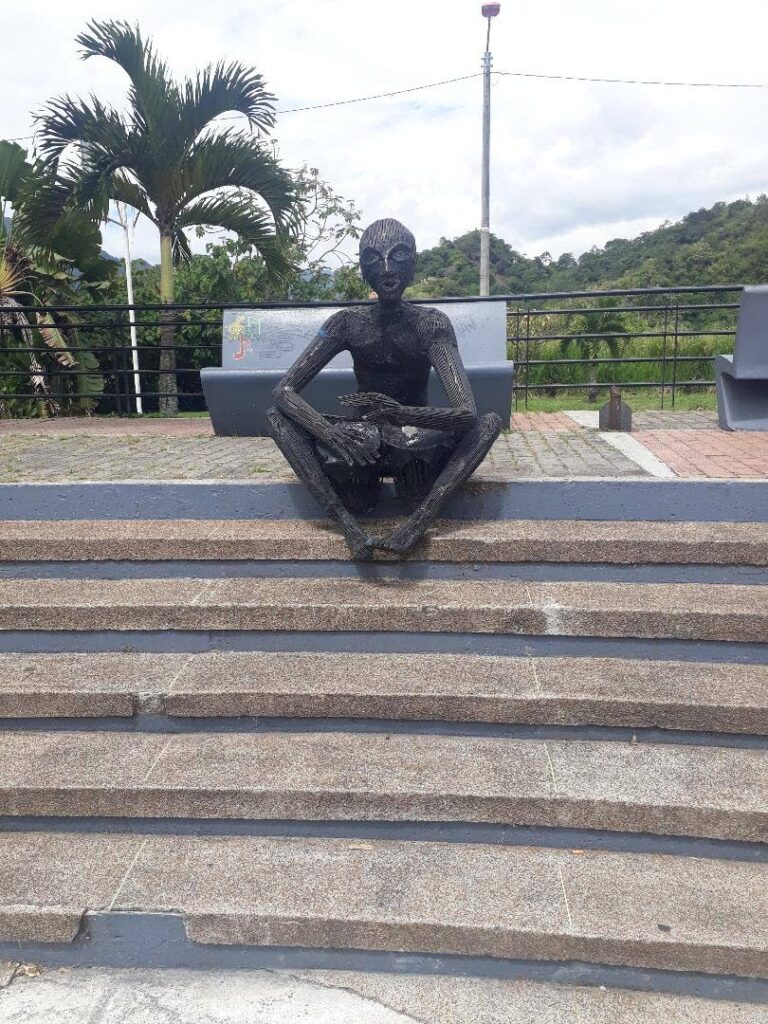Magical realism of Colombian towns

Part III
JAN WESTMAAS
We are into the fourth day of our Colombian 2023 adventure and have left Neiva for the Archaeological Park in San Agustin, about 220 kms away. It’s a relatively short distance by Colombian standards but, it’s off the beaten path. On my honeymoon visit in 1974, the entire road was unpaved. At times, the bus had to skirt around landslides and, at other times, had to come to a complete halt to allow the road to be cleared. Understandably, this time around (49 years after), the road had been properly paved and widened.
Why visit such a remote village in the remote eastern foothills of the Andes is the million-dollar question. For many people it certainly is more fashionable and even more accessible, though more costly, to get to the Mayan ruins of the Yucatan Peninsula in Mexico or even to the much-vaunted Inca city of Machu Picchu. The straightforward answer is that the park contains the largest collection of pre-Colombian religious monuments and megalithic sculptures in Latin America.
We reached our small and tastefully decorated eco-lodges, Anacaona and Finca El Cielo, before nightfall. Both also function as working farms (coffee and other crops) They offered nothing like the luxuries afforded us at the GHL hotel in Neiva. The warmth of the hosts in each lodging more than compensated for the chilly weather we experienced in San Agustin for two nights.
The following morning, Paul – the driver – dutifully drove us to the entrance to the park, three kilometers away. We bought our tickets and hired two guides. Soon we were off on a wet morning on an anticipated two-hour walk on a paved trail lined with tombs and with statues of varying heights.
We eventually reached what I consider the highlight of the morning – the Fuente Ceremonial de Lavapatas. This fountain served as a place for religious rituals, among other things. There was one pool for the shaman, one pool for women giving birth and one for the general population. In addition, we were able to observe the science behind a hydraulic system that so-called primitive people had developed millennia ago. “Fueron bastante civilizados” (highly civilised people) said the Spanish-speaking guide.

Later that evening, we hired a chiva – a rustic, rugged, colourfully painted truck with covered seats on its tray – to visit the Estrecho de Magdalena (Straits of Magdalena), about a 20-minute drive from the hotel. After clambering aboard, we were on our way on a mini-adventure that will last with us for the rest of our lives. On no account, Paul’s inter-city bus could have negotiated the narrow, stony, precipitous and downright dangerous road to get to the Straits of Magdalena, one of Colombia’s natural treasures.
It had rained heavily that afternoon and the river at its narrowest point (El Estrecho) had turned ferocious as it forced its way through a channel on its 1528-kilometre journey north-west to the Caribbean Sea. The Rio Magdalena resides deep in the heart of every Colombian. “Peel back the moments of any place, day or time in Colombia, dig through the memories of any family, and you will always find the Rio Magdalena,” writes Wade Davis, author of Magdalena: River of Dreams.
The following morning, we left San Agustin on a five-hour journey for Popayan, capital of the department of Cauca. Our route traversed the Purace National Park. It is a huge natural park (about 800 sq km) with a wide variety of eco-systems including paramo and rain forest. It is also the habitat of Colombia’s famed Spectacled Bear and the Pudu, a deer about 12-inches tall. We saw neither bear nor deer as we drove through the wilderness on a road, for the most part, full of potholes.

For a town with a relatively small population (about 320,000 inhabitants), Popayan’s impact extends way beyond its size. It’s famous for the Holy Week processions on Good Friday and Gloria Saturday which have been running continuously since the 16th century.
It’s known variously as the White City, The City of Presidents (19 presidents have from come from there), the City of Poets and Painters and the City of Gastronomy as declared by Unesco. In 1983, it had been devastated by a massive earthquake but fortunately it has been rebuilt, keeping most of its original character intact.
Mid-afternoon, we arrived and checked in for one night at the ideally located Hotel Dann Monasterio. The former Franciscan monastery (1570), re-purposed into an elegant four-star hotel, is a mere two blocks from Parque Caldas, in the historic centre of town. All the buildings, like our hotel, are painted colonial white! The one downside of this busy, vibrant, little town is the scarcity of traffic lights. “Cuidado las motos!” (Watch out for the motor bikes), our driver warned. He knew what he was saying. The bikers simply don’t give way to pedestrians as they rush about like “hormigas locas” (crazy ants).
I was dumbfounded when I witnessed a motorbike whizz by with four riders astride – man, woman, child and dog. I could not have experienced a more telling moment of magical realism than this. It was as if I had read a page out of a book by Gabriel Garcia Marquez, Colombia’s Nobel Prize winner whose work brings to life the truism – truth is stranger than fiction.

The following day, we left Popayan, travelling south-west to Cali, capital of the department of Valle del Cauca. To get there, we covered a distance of about 138 km. As we drew closer to Cali, the landscape changed dramatically. Thousands and thousands of acres of sugar cane fields, some not yet ready for harvesting, met our eyes. A significant amount of cane sugar is used to produce ethanol as fuel for Colombia’s vehicles. In 2020, raw sugar ranked as Colombia’s 12th most exported product.
Cali is a major industrial city. It’s located a mere 100 km from the port of Buenaventura on the Pacific Ocean. About 60 per cent of the country’s sea imports and exports pass through this port city. Cali is also not far from the department of Choco where the majority of the population are descendants of enslaved Africans. Cali is also one of Colombia’s most cosmopolitan cities with 44 per cent identifying as mixed race, 30 per cent as white, 20 per cent as African and four per cent as indigenous. On July 20, we were fortunate to be on spot to witness the city’s impressive Independence Day parade. The city’s ethnic diversity was evident in the faces of soldiers and police officers as they marched solemnly to the music of military bands.
We spent two nights at the Hotel Torre de Plaza where our group occupied 16 of its spacious rooms located in the tallest building in Cali – 44 stories high! The evening before our departure for Manizales, we paid a visit to Barrio San Antonio to imbibe the atmosphere in the charming, bohemian district overlooking the city. I was thrilled to point out our hotel that towered above all other buildings.
Manizales, capital of the department of Caldas, is about 264 km or about four hours away on an excellent highway from Cali. Paul’s driving skills were put to the test as he negotiated his way on steep, narrow streets to get to Hotel Carretero in the heart of Manizales. As we drew closer, a huge sign across the street read La Ciudad de Puertas Abiertas – City of Open Doors. It’s wasn’t long before we realized that this wasn’t a mere advertising gimmick. Manizaleños are a super polite, warm and open people.
With a refreshingly cool climate and surrounded on all sides by mountains of green, this mid-sized university town’s only handicap is the ever-present threat that the Nevado del Ruiz Volcano – 5,321m above sea level and 50 kms away – will one day erupt and wipe the town off the map.
Two other towns – Pereira and Ibague – lay on our loop before returning to Bogota where our adventure had started. Pereira is the capital of Risaraldas and Ibague is the capital of Tolima. They’re connected by a first class, winding road with countless, beautifully designed bridges of concrete and steel, some spanning deep canyons. The road continues through a multiplicity of tunnels cut into the mountains, lessening travelling time considerably. One infinitely long tunnel had me thinking that we were in Europe or North America.
In Pereira, we stopped to visit the 19th century Cathedral of Our Lady of Poverty with its intricate lattice work on its ceiling. In Plaza Bolivar, we also saw the statue of Simon Bolivar (Bolivar desnudo). Created by renowned Colombian sculptor Rodrigo Betancourt, it is the only sculpture of the Venezuelan liberator in the nude anywhere in the world.
We overnighted in Ibague. Before leaving for Bogota the following day, we made it our business to visit the Parque de La Musica with its many sculptures of musicians playing a variety of instruments. Ibague is referred to as the music capital of Colombia as the Conservatorio de Tolima, Colombia’s most important music school, is located there. Interestingly, Ibague, 200 km from Bogota, is also the home of Colombia’s central bank.
Back in Bogota, all that was left for us to do was to travel 40 km north of the city to the town of Zipaquira, where a cathedral was carved out of a salt mine 200m underground. For many on tour, Catholics and non-Catholics alike, our visit to the Cathedral de Sal was the crowning glory of our Colombian adventure.


Comments
"Magical realism of Colombian towns"